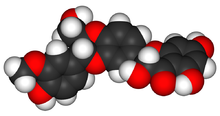シリビニン
シリビニン(silibinin: 国際一般名)は、マリアアザミ ('Silybum marianum') 種子の標準化された抽出物であるシリマリン (silymarin)の主要な活性成分である。シリビン(silybin)としても知られている。シリマリンはシリビニン、イソシリビニン、シリクリスチン、シリジアニンといったフラボノリグナン類の混合物である。シリビニン自身は2つのジアステレオマー、シリビニンAおよびシリビニンBのおよそ等モル比の混合物である。シリビニンAは2R, 3R, 7‘R, 8‘R体、シリビニンB は2R, 3R, 7‘S, 8‘S体である[1]。In vitroおよび動物実験において、シリビニンは毒素から肝臓を保護する肝保護作用を有していることが示唆されている[2] [3]。シリビニンはまた、ヒト前立腺腺癌細胞、エストロゲン依存性ならびに非依存性ヒト乳腺癌細胞、ヒト子宮膣部癌細胞、ヒト大腸癌細胞、小細胞ならびに非小細胞ヒト肺癌細胞に対して抗がん作用を示すことが明らかにされている[4][5][6][7]。
 | |
 | |
| IUPAC命名法による物質名 | |
|---|---|
| |
| 臨床データ | |
| Drugs.com |
国別販売名(英語) International Drug Names |
| 識別 | |
| CAS番号 | 22888-70-6 |
| ATCコード | A05BA03 (WHO) |
| PubChem | CID: 31553 |
| ChemSpider | 29263 |
| UNII | 4RKY41TBTF |
| KEGG | D08515 |
| ChEMBL | CHEMBL9509 |
| 化学的データ | |
| 化学式 | C25H22O10 |
| 分子量 | 482.44 g/mol |
| |
| |
化学的に修飾されたシリビニンであるシリビニンC-2',3-ビス-(水素スクシナート)二ナトリウム塩(商品名 Legalon SIL)は注射薬として、タマゴテングタケ (Amanita phalloides) 中毒といった肝毒物質による重症中毒に対する治療に用いられている[8]。また、アルコール性およびグレードchild Aの肝硬変における支援要素としてのシリビニンの使用に関する臨床的証拠がある [9]。
薬理学 編集
シリマリンの水溶性ならびに生物学的利用能の低さは製剤の改善を促した。シリマリンとホスファチジルコリンの複合体であるシリピド(silipide、商品名 シリフォス Siliphos)は、シリマリンよりも約10倍生物学的利用能が優れている[10]。シリマリンのβ-シクロデキストリン包接錯体はシリマリンよりも優れた溶解性を示すことが報告されている[11]。調製されたシリビニン配糖体は、シリビニンよりも高い水溶性と肝保護効果を示すことも報告されている[12]。
フラボノイドであるシリマリンはP糖タンパク質による細胞排出を阻害することが示されている[13]。P糖タンパク質活性の調節によりP糖タンパク質の基質となる薬物の吸収や生物学的利用能に変化が生じる。また、シリマリンはシトクロムP450を阻害することが報告されていることから、P450によって解毒される薬物との相互作用の可能性も排除できない[14]。
毒性 編集
シリマリンおよびシリビニンの急性毒性は様々な動物種において経口ならびに静脈投与によって調べられている。20 g/kgのシリマリンを経口投与されたマウスおよび1 g/kgを経口投与されたイヌは、投与後に死亡せず副作用の兆候も見られなかった。静脈内注射後の半数致死量 (LD50) はマウスで400 mg/kg、ラットで385 mg/kg、ウサギおよびイヌで140 mg/kgであった。
補完代替医療 編集
最近の研究ではシリマリンは血糖値制御を補助することによって2型糖尿病患者の助けとなることも示唆されている[15]。
マウスを用いた実験室レベルの研究ではシリビニンはタマゴテングタケ (Amanita phalloides) に含まれるα-アマニチンから肝細胞を保護することが示されている。
脚注 編集
- ^ Lee DY, Liu Y (2003). “Molecular structure and stereochemistry of silybin A, silybin B, isosilybin A, and isosilybin B, Isolated from Silybum marianum (milk thistle)”. J. Nat. Prod. 66 (9): 1171-1174. doi:10.1021/np030163b. PMID 14510591.
- ^ Al-Anati L, Essid E, Reinehr R, Petzinger E (2009). “Silibinin protects OTA-mediated TNF-α release from perfused rat livers and isolated rat Kupffer cells”. Mol. Nutr. Food Res. 53 (4): 460–6. doi:10.1002/mnfr.200800110. PMID 19156713.
- ^ Jayaraj R, Deb U, Bhaskar AS, Prasad GB, Rao PV (2007). “Hepatoprotective efficacy of certain flavonoids against microcystin induced toxicity in mice”. Envir. Toxicol. 22 (5): 472–9. doi:10.1002/tox.20283. PMID 17696131.
- ^ Mokhtari MJ, Motamed N, Shokrgozar MA (2008). “Evaluation of silibinin on the viability, migration and adhesion of the human prostate adenocarcinoma (PC-3) cell line”. Cell Biol. Int. 32 (8): 888–92. doi:10.1016/j.cellbi.2008.03.019. PMID 18538589.
- ^ Bhatia N, Zhao J, Wolf DM, Agarwal R (1999). “Inhibition of human carcinoma cell growth and DNA synthesis by silibinin, an active constituent of milk thistle: comparison with silymarin”. Cancer Lett. 147 (1–2): 77–84. doi:10.1016/S0304-3835(99)00276-1. PMID 10660092.
- ^ Hogan FS, Krishnegowda NK, Mikhailova M, Kahlenberg MS (2007). “Flavonoid, silibinin, inhibits proliferation and promotes cell-cycle arrest of human colon cancer”. J. Surg. Res. 143 (1): 58–65. doi:10.1016/j.jss.2007.03.080. PMID 17950073.
- ^ Sharma G, Singh RP, Chan DC, Agarwal R (2003). “Silibinin induces growth inhibition and apoptotic cell death in human lung carcinoma cells”. Anticancer Res. 23 (3B): 2649–55. PMID 12894553.
- ^ Mitchell, T (2009). “Intravenous Milk thistle (silibinin-legalon) for hepatic failure induced by amatoxin/Amanita mushroom poisoning”. (Clinical study).
- ^ Saller R, Brignoli R, Melzer J, Meier R (2008). “An updated systematic review with meta-analysis for the clinical evidence of silymarin”. Forsch. Komplementärmed. 15 (1): 9–20. doi:10.1159/000113648. PMID 18334810.
- ^ Kidd P, Head K (2005). “A review of the bioavailability and clinical efficacy of milk thistle phytosome: a silybin-phosphatidylcholine complex (Siliphos)”. Altern. Med. Rev. 10 (3): 193–203. PMID 16164374 2010年12月14日閲覧。.
- ^ Voinovich D, Perissutti B, Grassi M, Passerini N, Bigotto A (2009). “Solid state mechanochemical activation of Silybum marianum dry extract with betacyclodextrins: Characterization and bioavailability of the coground systems”. J. Pharm. Sci. 98 (11): 4119–29. doi:10.1002/jps.21704. PMID 19226635.
- ^ Kosina P, Kren V, Gebhardt R, Grambal F, Ulrichová J, Walterová D (2002). “Antioxidant properties of silybin glycosides”. Phytother. Res. 16 Suppl 1: S33–9. doi:10.1002/ptr.796. PMID 11933137.
- ^ Zhou S, Lim LY, Chowbay B (2004). “Herbal modulation of P-glycoprotein”. Drug Metab. Rev. 36 (1): 57–104. doi:10.1081/DMR-120028427. PMID 15072439.
- ^ Wu JW, Lin LC, Tsai TH (2009). “Drug-drug interactions of silymarin on the perspective of pharmacokinetics”. J. Ethnopharmacol. 121 (2): 185–93. doi:10.1016/j.jep.2008.10.036. PMID 19041708.
- ^ Huseini HF, Larijani B, Heshmat R, Fakhrzadeh H, Radjabipour B, Toliat T, Raza M (2006). “The efficacy of Silybum marianum (L.) Gaertn. (silymarin) in the treatment of type II diabetes: a randomized, double-blind, placebo-controlled, clinical trial”. Phytother. Res. 20 (12): 1036–9. doi:10.1002/ptr.1988. PMID 17072885.
参考文献 編集
- Morazzoni P, Bombardelli E (1994). “Silybum marianum (cardus marianus)”. Fitoterapia 66: 3–42.
- Saller R, Meier R, Brignoli R (2001). “The use of silymarin in the treatment of liver diseases”. Drugs 61 (14): 2035–63. doi:10.2165/00003495-200161140-00003. PMID 11735632.